- CONTENTS:
- Table of ContentsLetter from the EditorSustainability and the Bottom Line: The Responsible Collusion of Economics, Social Responsibility, and the EnvironmentProgress Toward Zero: The Climb to SustainabilityPlant Tour and Meeting with Members of Interface's Sustainability Team: December 16, 2009Driving Sustainable Innovation: A Pioneer for the 21st CenturySucceeding Through Collaborative Conflict: The Paradoxical Lessons of Shared LeadershipClimate 2030: A National Blueprint for a Clean Energy EconomySpiritual Enterprise: Doing Virtuous Business
- CLIMATE 2030: A NATIONAL BLUEPRINT FOR A CLEAN ENERGY ECONOMY


RACHEL CLEETUS, ECONOMIST, UCS CLIMATE PROGRAM
STEVEN CLEMMER, RESEARCH DIRECTOR, UCS CLEAN ENERGY PROGRAM
DAVID FRIEDMAN, RESEARCH DIRECTOR, UCS CLEAN VEHICLES PROGRAM
UNION OF CONCERNED SCIENTISTS*
CAMBRIDGE, MA (National Headquarters), WASHINGTON, D.C., BERKELEY, CA, CHICAGO, ILBuilding a Revitalized Clean Energy Economy
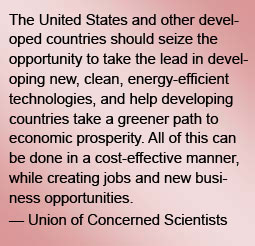 Reducing oil dependence. Strengthening energy security. Creating jobs. Tackling global warming. Addressing air pollution. Improving our health. The United States has many reasons to make the transition to a clean energy economy. What we need is a comprehensive set of smart policies to jump-start this transition without delay and maximize the benefits to our environment and economy. Climate 2030: A National Blueprint for a Clean Energy Economy (“the Blueprint”)** answers that need.
Reducing oil dependence. Strengthening energy security. Creating jobs. Tackling global warming. Addressing air pollution. Improving our health. The United States has many reasons to make the transition to a clean energy economy. What we need is a comprehensive set of smart policies to jump-start this transition without delay and maximize the benefits to our environment and economy. Climate 2030: A National Blueprint for a Clean Energy Economy (“the Blueprint”)** answers that need.Recent rapid growth of the wind industry (developers have installed more wind power in the United States in the last two years than in the previous 20) and strong sales growth of hybrid vehicles show that the U.S. transformation to a clean energy economy is already under way. However, these changes are still too gradual to address our urgent need to reduce heat-trapping emissions to levels that are necessary to protect the well-being of our citizens and the health of our environment.
Global warming stems from the release of carbon dioxide and other heat-trapping gases into the atmosphere, primarily when we burn fossil fuels and clear forests (see Figure ES.1). The problems resulting from the ensuing carbon overload range from extreme heat, droughts, and storms to acidifying oceans and rising sea levels. To help avoid the worst of these effects, the United States must play a lead role and begin to cut its heat-trapping emissions today—and aim for at least an 80 percent drop from 2005 levels by 2050.
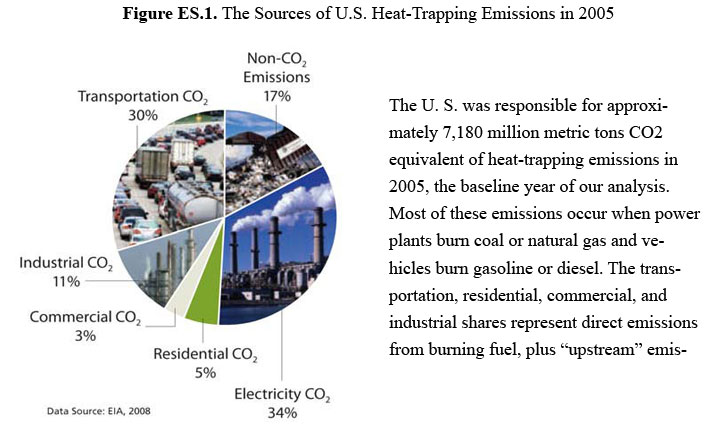
The Climate 2030 Approach
This report analyzes the economic and technological feasibility of meeting stringent targets for reducing global warming emissions, with a cap set at 26 percent below 2005 levels by 2020, and 56 percent below 2005 levels by 2030. Meeting this cap means the United States would limit total emissions — the crucial measure for the climate — to 180,000 million metric tons carbon dioxide equivalent (MMTCO2eq) from 2000 to 2030.*
The nation’s long-term carbon budget for 2000 to 2050—as defined in a previous UCS analysis (Luers et al. 2007) — is 160,000 to 265,000 MMTCO2eq. The 2000–2030 carbon budget in our analysis would put us on track to reach the mid-range of that long-term budget by 2050, if the nation continues to cut emissions steeply.
To reach the 2020 and 2030 cap and carbon budget targets, the Blueprint proposes a comprehensive policy approach (the “Blueprint policies”) that combines an economy-wide cap-and-trade program with complementary policies. This approach finds cost-effective ways to reduce fossil fuel emissions throughout our economy — including in industry, buildings, electricity, and transportation — and to store carbon through agricultural activities and forestry.
Our analysis relies primarily on a modified version of the U.S. Department of Energy’s National Energy Modeling System (referred to as UCS-NEMS). We supplemented that model with an analysis of the impact of greater energy efficiency in industry and buildings by the American Council for an Energy Efficient Economy. We also worked with researchers at the University of Tennessee to analyze the potential for crops and residues to provide biomass energy. We then combined our model with those studies to capture the dynamic interplay between energy use, energy prices, energy investments, and the economy while also considering competition for limited resources and land.
Our analysis explores two main scenarios. The first — which we call the Reference case — assumes no new climate, energy, or transportation policies beyond those already in place as of October 2008.** The second — the Blueprint case — examines an economy-wide cap-and-trade program, plus a suite of complementary policies to boost energy efficiency and the use of renewable energy in key economic sectors: industry, buildings, electricity, and transportation. Our analysis also includes a third “sensitivity” scenario that strips out the policies targeted at those sectors, which we refer to as the No Complementary Policies case.
Our analysis shows that the technologies and policies pursued under the Blueprint produce dramatic changes in energy use and cuts in carbon emissions. The analysis also shows that consumers and businesses reap significant net savings under the comprehensive Blueprint approach, while the nation sees strong economic growth.
* This amount is equivalent to the emissions from nearly 1 billion of today’s U.S. cars and trucks over the same 30-year period. The nation now has some 230 million cars and trucks, and more than 1 billion vehicles are on the road worldwide. Given today’s trends, we can expect at least 2 billion vehicles by 2030 (Sperling and Gordon 2009).
** Our analysis includes the tax credits and incentives for energy technologies included in the October 2008 Economic Stimulus Package (H.R. 6049), as well as the transportation and energy policies in the 2007 Energy Independence and Security Act. However, the timing of the February 2009 American Recovery and Reinvestment Act did not allow us to incorporate its significant additional incentives.
The Blueprint Cuts Carbon Emissions and Saves Money
Blueprint policies lower U.S. heat-trapping emissions to meet a cap set at 26 percent below 2005 levels in 2020, and 56 percent below 2005 levels in 2030 (see Figure ES.2). The actual year-by-year emissions reductions differ from the levels set in the cap because firms have the flexibility to over-comply with the cap in early years, bank allowances, and then use them to meet the cap requirements in later years.
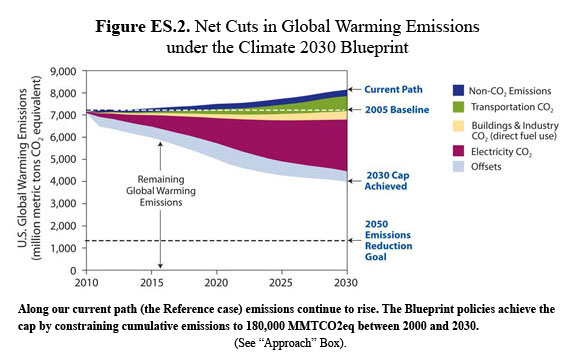
To meet the cap, the cumulative actual emissions must equal the cumulative tons of emissions set by the cap. In 2030, we achieve this goal.
The nation achieves these deep cuts in carbon emissions while saving consumers and businesses $465 billion annually by 2030. The Blueprint also builds $1.7 trillion in net cumulative savings between 2010 and 2030.1
Blueprint policies stimulate significant consumer, business, and government investment in new technologies and measures by 2030. The resulting savings on energy bills from reductions in electricity and fuel use more than offset the costs of these additional investments. The result is net annual savings for households, vehicle owners, businesses, and industries of $255 billion by 2030.2
We included an additional $8 billion in government-related costs to administer and implement the policies. However, auctioning carbon allowances will generate $219 billion in revenues that is invested back into the economy.3 This brings annual Blueprint savings up to $465 billion by 2030.4
Under the Blueprint, every region of the country stands to save billions (see Figure ES.3). Households and businesses — even in coal-dependent regions — will share in these savings.
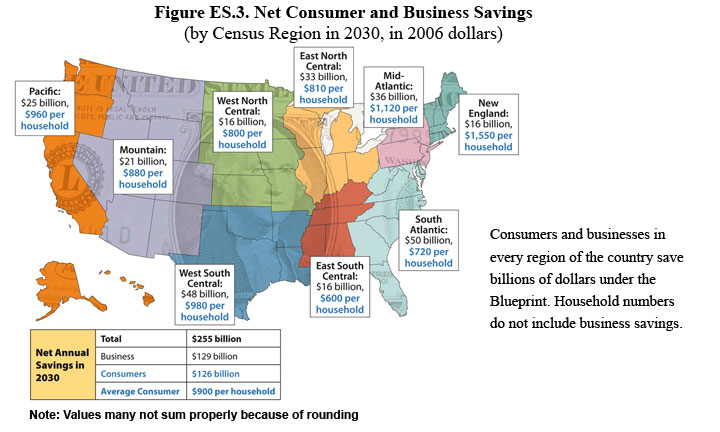
The Blueprint keeps carbon prices low. Under the Blueprint, the price of carbon allowances starts at about $18 per ton of CO2 in 2011, and then rises to $34 in 2020, and to $70 in 2030 (all in 2006 dollars). Those prices are well within the range that other analyses find, despite our stricter cap on economy-wide emissions.
In addition, the Blueprint achieves much larger cuts in carbon emissions within the capped sectors because of the tighter limits that we set on “offsets”5 and because of our more realistic assumptions about the cost-effectiveness of investments in energy efficiency and renewable energy technologies.
The economy grows by at least 81 percent by 2030 under the Blueprint. U.S. gross domestic product (GDP) expands by 81 percent between 2005 and 2030 under our approach — virtually the same as in the Reference case, which shows the U.S. economy growing by 84 percent. In fact, our model predicts that the Blueprint will slow economic growth by less than 1.5 percent in 2030 — equivalent to only 10 months of economic growth over the 25-year period.6
The Blueprint also shows practically the same employment trends as the Reference case. In fact, non-farm employment is slightly higher under the Blueprint than in the Reference case (170 million jobs versus 169.4 million in 2030).
We should note that there are significant limitations in the way NEMS accounts for the GDP and employment effects of the Blueprint policies. NEMS does not fully consider the economic growth that would arise from investments in clean technology, or from the spending of the money consumers and businesses saved on energy due to these investments. And the Reference case does not include the costs of global warming itself.
The Blueprint cuts the annual household cost of energy and transportation by $900 in 2030. The average U.S. household would see net savings on electricity, natural gas, and oil of $320 per year compared with the Reference case, after paying for investments in new energy efficiency and low-carbon technologies.
Transportation expenses for the average household would fall by about $580 per year in 2030. Those savings take into account the higher costs of cleaner cars and trucks, new fees used to fund more public transit, and declining use of gasoline.
Businesses save nearly $130 billion in energy-related expenses annually by 2030 under the Blueprint. Neither the energy nor the transportation savings account for the revenue from auctioning carbon allowances that will be invested back into the economy, lowering consumer and business costs (or increasing consumer and business savings) even further.
The Blueprint Changes the Energy We Use. Blueprint policies reduce projected U.S. energy use by one-third by 2030. Significant increases in energy efficiency across the economy and reductions in car and truck travel drive down energy demand and carbon emissions.
Carbon-free electricity and low-carbon fuels together make up more than one-third of the remaining U.S. energy use by 2030. A significant portion of U.S. reductions in carbon emissions in 2030 comes from a 25 percent increase in the use of renewable energy from wind, solar, geothermal, and bio-energy under the Blueprint. Carbon emissions are also kept low because the use of nuclear energy and hydropower — which do not directly produce carbon emissions — remain nearly the same as in the Reference case.
The Blueprint reduces U.S. dependence on oil and oil imports. By 2030, the Blueprint cuts the use of oil and other petroleum products by 6 million barrels per day, compared with 2005. That is as much oil as the nation now imports from the 12 members of OPEC (the Organization of Petroleum Exporting Countries). Those reductions will help drop imports to less than 45 percent of the nation’s oil needs, and cut projected expenditures on those imports by more than $85 billion in 2030, or more than $160,000 per minute.
Smart Energy and Transportation Policies Are Essential for the Greatest Savings
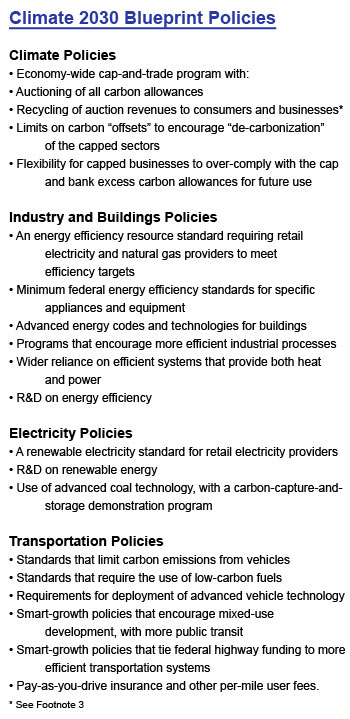 Many of the Blueprint’s complementary policies have a proven track record at state and federal levels. These policies include emission standards for vehicles and fuels, energy efficiency standards for appliances, buildings, and industry, and renewable energy standards for electricity (see box). The Blueprint also relies on innovative policies to reduce the number of miles people travel in their cars and trucks.
Many of the Blueprint’s complementary policies have a proven track record at state and federal levels. These policies include emission standards for vehicles and fuels, energy efficiency standards for appliances, buildings, and industry, and renewable energy standards for electricity (see box). The Blueprint also relies on innovative policies to reduce the number of miles people travel in their cars and trucks.These policies are essential to delivering significant consumer and business savings under the Blueprint. Our No Complementary Policies case shows that if we remove these policies from the Blueprint, consumers and businesses will save much less money.7 Excluding the complementary policies we recommend for the energy and transportation sectors would reduce net cumulative consumer and business savings through 2030 from a total of $1.7 trillion to $0.6 trillion (see Figure ES.4).
Our No Complementary Policies case also shows that excluding the policies we recommend for the energy and transportation sectors will double the price of carbon allowances.
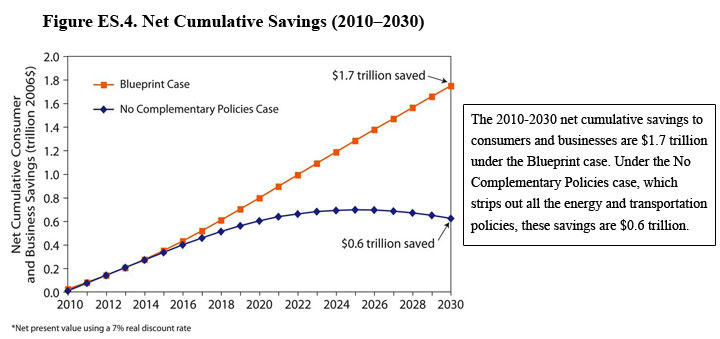
Where the Blueprint Cuts Emissions and Saves Money
Five sectors of the U.S. economy account for the majority of the nation’s heat-trapping emissions: electricity, transportation, buildings (commercial and residential), industry, and land use. Blueprint policies ensure that each of these sectors contributes to the drop in the nation’s net carbon emissions.
The electricity sector — with help from efficiency improvements in industry and buildings — leads the way by providing more than half (57 percent) of the needed cuts in heat-trapping emissions by 2030. Transportation delivers the next-largest cut (16 percent). Carbon offsets provide 11 percent of the overall cuts in carbon emissions by 2030. Reduced emissions of heat-trapping gases other than carbon dioxide (non-CO2 emissions) deliver another 7 percent of the cuts. Savings in direct fuel use in the residential, commercial, and industrial sectors are the final pieces, contributing 3 percent, 2 percent, and 4 percent, respectively, of the reductions in emissions (see Figure ES.5).
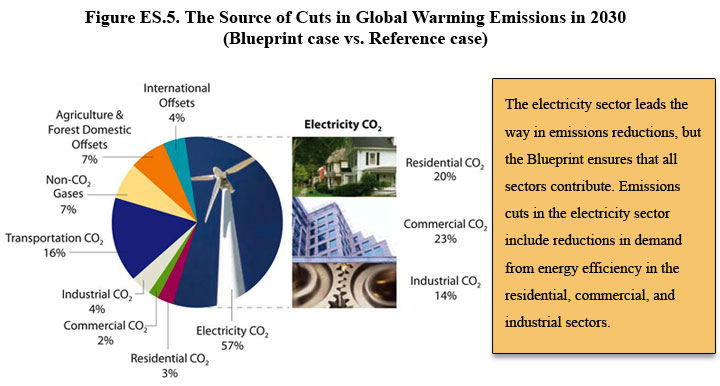
National savings on annual energy bills (the money consumers save on their monthly electricity bills or gasoline costs, for example) total $414 billion in 2030. As noted, these savings more than cover the costs of carbon allowances that utilities and fuel providers pass through to households and businesses in higher energy prices. The incremental costs of energy investments (expenditures on energy-consuming products such as homes, appliances, and vehicles) reach $160 billion. The result is net annual savings of $255 billion for households and businesses in 2030.
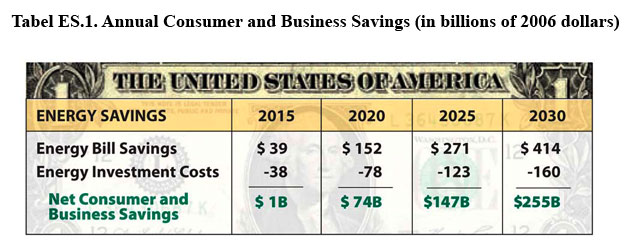
Energy bill savings include the costs of renewable electricity, carbon capture and storage, and renewable fuels that are passed on to consumers and businesses on their energy bills. Energy investments costs include the cost of more efficient appliances and buildings, cleaner cars and trucks, and a more efficient transportation system. Note: Values may not sum properly because of rounding.
Households and businesses that rely on the transportation sector see nearly half of the net annual savings ($119 billion) in 2030. However, Blueprint policies ensure that consumers and businesses throughout the economy save money on energy expenses. Lower electricity costs for industrial, commercial, and residential customers are responsible for $118 billion in net annual savings (see Figure ES.6).
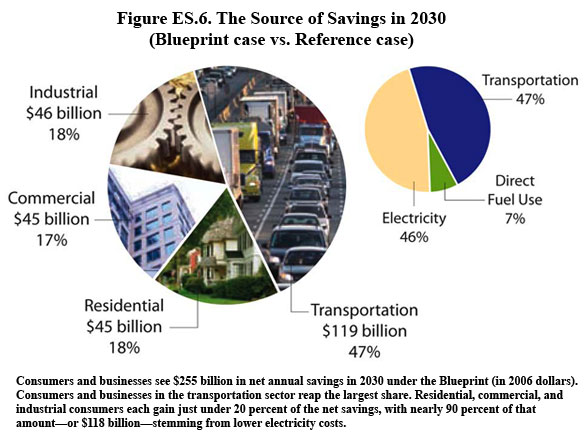
The Blueprint Cuts Emissions in Each Sector
Blueprint policies dramatically reduce carbon emissions from power plants. Under the Blueprint, carbon emissions from power plants are 84 percent below 2005 levels by 2030. Sulfur dioxide (SO2), nitrogen oxides (NOx), and mercury pollution from power plants are also significantly lower, improving air and water quality, and providing important public health benefits.
Most of these cuts in emissions come from reducing the use of coal to produce electricity through greater use of energy efficiency and renewable energy technologies. For example, energy efficiency measures — such as advanced buildings and industrial processes — and high-efficiency appliances, lighting, and motors reduce demand for electricity by 35 percent below the Reference case by 2030. The use of efficient combined-heat-and-power systems that rely on natural gas in the commercial and industrial sectors more than triples over current levels, providing 16 percent of U.S. electricity by 2030. And largely because of a national renewable electricity standard, wind, solar, geothermal, and bio-energy provide 40 percent of the remaining electricity.
Hydropower and nuclear power continue to play important roles, generating slightly more carbon-free electricity in 2030 than they do today. Efforts to capture and store carbon from advanced coal plants, and new advanced nuclear plants, play a minor role, as our analysis shows they will not be economically competitive with investments in energy efficiency and many renewable technologies. However, carbon capture and storage and advanced nuclear power could play a more significant role both before and after 2030 if their costs decline faster than expected, or if the nation does not pursue the vigorous energy efficiency and renewable energy policies and investments we recommend.
Industry and buildings cut fuel use through greater energy efficiency. By 2030, a drop in direct fuel used in industry and buildings accounts for 9 percent of the cuts in carbon emissions from non-electricity sources under the Blueprint.
Transportation gets cleaner, smarter, and more efficient. Under the Blueprint, carbon emissions from cars and light trucks are 40 percent below 2005 levels by 2030. Global warming emissions from freight trucks hold steady despite a more than 80 percent growth in the nation’s economy. However, carbon emissions from airplanes continue to grow nearly unchecked, pointing to the need for specific policies targeting that sector. Overall, carbon emissions from the transportation sector fall 19 percent below 2005 levels by 2030 — and more than 30 percent below the Reference case.
Much of the improvement in this sector comes from greater vehicle efficiency and the use of the lowest-carbon fuels, such as ethanol made from plant cellulose. Measures to encourage more efficient travel options — such as per-mile insurance and congestion fees, and more emphasis on compact development linked to transit — also provide significant reductions. Renewable electricity use in advanced vehicles such as plug-in hybrids begins to grow significantly by 2030.
These advances represent the second half of an investment in a cleaner transportation system that began with the 2007 Energy Independence and Security Act.8 These investments provide immediate benefits and will be essential to dramatically cutting carbon emissions from the transportation sector by 2050.
Blueprint Cuts Are Conservative and Practical
The Blueprint includes only technologies that are commercially available today, or that will very likely be available within the next two decades. Our analysis excludes many promising technologies, or assumes they will play only a modest role by 2030. We also did not analyze the full potential for storing more carbon in U.S. agricultural soils and forests, although studies show that such storage could be significant.
Our estimates of cuts in carbon emissions are therefore conservative. More aggressive policies and larger investments in clean technologies could produce even deeper U.S. reductions.
Recommendations: Building Blocks for a Clean Energy Future
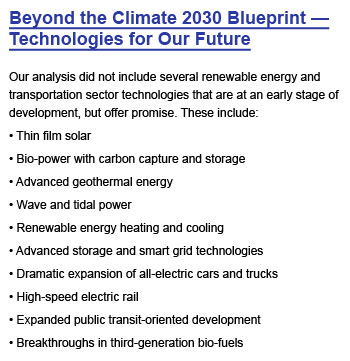 Given the significant savings under the Blueprint, building a clean energy economy not only makes sense for our health and well-being and the future of our planet, but is clearly also good for our economy. However, the nation will only realize the benefits of the Climate 2030 Blueprint if we quickly put the critical policies in place — some as soon as 2010. All these policies are achievable, but near-term action is essential.
Given the significant savings under the Blueprint, building a clean energy economy not only makes sense for our health and well-being and the future of our planet, but is clearly also good for our economy. However, the nation will only realize the benefits of the Climate 2030 Blueprint if we quickly put the critical policies in place — some as soon as 2010. All these policies are achievable, but near-term action is essential.An important first step is science-based legislation that would enable the nation to cut heat-trapping emissions by at least 35 percent below 2005 levels by 2020,9 and at least 80 percent by 2050. Such legislation would include a well-designed cap-and-trade program that guarantees the needed emission cuts and does not include loopholes, such as “safety valves” that prevent the free functioning of the carbon market.
 Equally important, policy makers should require greater energy efficiency and the use of renewable energy in industry, buildings, and electricity. Policy makers should also require and provide incentives for cleaner cars, trucks, and fuels and better alternatives to car and truck travel.
Equally important, policy makers should require greater energy efficiency and the use of renewable energy in industry, buildings, and electricity. Policy makers should also require and provide incentives for cleaner cars, trucks, and fuels and better alternatives to car and truck travel.U.S. climate policy must also have an international dimension. That dimension should include funding the preservation of tropical forests, sharing energy efficiency and renewable energy technologies with developing nations, and helping those nations adapt to the unavoidable effects of climate change.
Impact of the Blueprint Policies in 2020
A central insight from the Blueprint analysis is that the nation has many opportunities for making cost-effective cuts in carbon emissions in the next 10 years (through 2020). Our analysis shows that firms subject to the cap on emissions find it cost-effective to cut emissions more than required — and to bank carbon allowances for future years. Energy efficiency, renewable energy, reduced vehicle travel, and carbon offsets all contribute to these significant near-term reductions.
By 2020, we find that the United States can:
- Achieve, and go beyond, the cap requirement of a 26 percent reduction in emissions below 2005 levels, at a net annual savings of $243 billion to consumers and businesses. The reductions in excess of the cap are banked by firms for their use in later years to comply with the cap and lower costs.
- Reduce annual energy use by 17 percent compared with the Reference case levels.
- Cut the use of oil and other petroleum products by 3.4 million barrels per day compared with 2005, reducing imports to 50 percent of our needs.
- Reduce annual electricity generation by almost 20 percent compared with the Reference case while producing 10 percent of the remaining electricity with combined heat and power and 20 percent with renewable energy sources, such as wind, solar, geothermal, and bio-energy.
- Rely on complementary policies to deliver cost effective energy efficiency, conservation, and renewable energy solutions. Excluding those energy and transportation sector policies from the Blueprint would reduce net cumulative consumer savings through 2020 from $795 billion to $602 billion.
Conclusion
We are at a crossroads. The Reference case shows that we are on a path of rising energy use and heat-trapping emissions. We are already seeing significant impacts from this carbon overload, such as rising temperatures and sea levels and extreme weather events. If such emissions continue to climb at their current rate, we could reach climate “tipping points” and face irreversible changes to our planet.
In 2007 the Intergovernmental Panel on Climate Change (IPC) found it “unequivocal” that the Earth’s climate is warming, and that human activities are the primary cause (IPCC 2007). The IPCC report concludes that unchecked global warming will only create more adverse impacts on food production, public health, and species survival.
The climate will not wait for us. More recent studies have shown that the measured impacts—such as rising sea levels and shrinking summer sea ice in the Arctic—are occurring more quickly, and often more intensely, than IPC projections (Rosenzweig et al. 2008; Rahmstorf et al. 2007; Stroeve et al. 2007).
The most expensive thing we can do is nothing. One study also estimates that if climate trends continue, the total cost of global warming in the United States could be as high as 3.6 percent of GDP by 2100 (Ackerman and Stanton 2008).
The Climate 2030 Blueprint demonstrates that we can choose to cut our carbon emissions while maintaining robust economic growth and achieving significant energy-related savings. While the Blueprint policies are not the only path forward, a near-term comprehensive suite of climate, energy, and transportation policies is essential if we are to curb global warming in an economically sound fashion. These near-term policies are also only the beginning of the journey toward achieving a clean energy economy. The nation can and must expand these and other policies beyond 2030 to ensure that we meet the mid-century reductions in emissions that scientists deem necessary to avoid the worst consequences of global warming.
ENDNOTES
1 Unless otherwise noted, all amounts are in 2006 dollars, and cumulative figures are discounted using a 7 percent real discount rate.
2 Net savings include both energy bills (the direct cost of energy such as diesel, electricity, gasoline, and natural gas) and the cost of purchasing more efficient energy-consuming products such as appliances and vehicles. The cost of carbon allowances passed through to consumers and businesses is also included in their energy bills.
3 We could not model a targeted way of recycling these revenues. The preferred approach would be to target revenues from auctions of carbon allowances toward investments in energy efficiency, renewable energy, and protection for tropical forests, as well as transition assistance to consumers, workers, and businesses in moving to a clean energy economy. However, limitations in the NEMS model prevented us from directing auction revenues to specific uses. Instead, we could only recycle revenues in a general way to consumers and businesses.
4 Values may not sum properly due to rounding.
5 In a cap-and-trade system, rather than cutting their emissions directly, capped companies can “offset” them by paying uncapped third parties to reduce their emissions instead. The cap-and-trade program we modeled includes offsets from storing carbon in domestic soils and vegetation — set at a maximum of 10 percent of the emissions cap, to encourage “de-carbonization” of the capped sectors — and from investing in reductions in other countries, mainly from preserving tropical forests, set at a maximum of 5 percent of the emissions cap.
6 This means that under the Blueprint the economy reaches the same level of economic growth in October 2030 as the Reference case reaches in January 2030.
7 Some or all of the economic benefits of the complementary policies could also occur if policy makers effectively use the revenues from auctioning carbon allowances to fund the technologies and measures included in these policies. Our study did not address that approach.
8 Because our Reference case includes the policies in the 2007 legislation, the Blueprint’s 30 percent reduction from that case in 2030 represents benefits beyond those delivered from the fuel economy standards and renewable fuel standard in the act. If our Reference case did not include the provisions in the act, Blueprint transportation policies would deliver nearly a 40 percent reduction compared with the Reference case.
9 Note that this recommendation encompasses more possibilities for reducing emissions than we were able to model in UCS-NEMS. For example, investments in reducing emissions from tropical deforestation could help meet this 2020 target. The Blueprint reductions can and should be supplemented by these and other sources of emissions reductions.
REFERENCES
Ackerman, F., and E.A. Stanton 2008. The cost of climate change: What we’ll pay if global warming continues unchecked. New York, NY: Natural Resources Defense Council. Reference online at http://www.nrdc.org/globalWarming/cost/cost.pdf.
Intergovernmental Panel on Climate Change (IPCC) 2007. Climate change 2007: The physical science basis. Contribution of Working Group I to the Fourth Assessment Report of the Intergovernmental Panel on Climate Change, edited by S. Solomon, D. Qin, M. Manning, Z. Chen, M. Marquis, K.B. Averyt, M.Tignor, and H.L. Miller. Cambridge, UK: Cambridge University Press.
Luers, A.L., M.D. Mastrandrea, K. Hayhoe, and P.C. Frumhoff 2007. How to avoid dangerous climate change: A target for U.S. emissions reductions. Cambridge, MA: Union of Concerned Scientists. Rahmstorf, S., A. Cazenave, J.A. Church, J.E. Hansen, R.F. Keeling, D.E. Parker, and R.C.J. Somerville. 2007. Recent climate observations compared to projections. Science 316:709.
Rosenzweig, C., D. Karoly, M. Vicarelli, P. Neofotis, Q. Wu, G. Casassa, A. Menzel, T.L. Root, N. Estrella, B. Seguin, P. Tryjanowski, C. Liu, S. Rawlins, and A. Imeson. 2008. Attributing physical and biological impacts to anthropogenic climate change. Nature, 453: 353–357.
Sperling, D., and D. Gordon 2009. Two billion cars: Driving toward sustainability. New York: Oxford University Press.
Stroeve, J., M. Serreze, S. Drobot, S. Gearheard, M. Holland, J. Maslanik, W. Meier, and T. Scambos 2008. Arctic sea ice extent plummets in 2007. Eos, Transactions, American Geophysical Union 89(2):13–20.
CONTRIBUTORS
This analysis was conducted by a large, interdisciplinary team within UCS including energy and vehicle analysts Don Anair, Jeff Deyette, Jeremy Martin, Patricia Monahan, John Rogers, and Sandra Sattler. Modeling support was provided by OnLocation, Inc. John “Skip” Laitner and others at the American Council for an Energy-Efficient Economy (ACEEE) provided an analysis of the impact of greater energy efficiency in industry and buildings. An additional analysis on biomass potential was provided by Marie Walsh at the University of Tennessee. Nora Greenglass and Richard A. Houghton of the Woods Hole Research Center provided expertise on carbon sequestration in the agriculture and forestry sector.
REVIEWERS
Frank Ackerman (Stockholm Environment Institute–U.S. Center), Jeff Alson (U.S. Environmental Protection Agency), Doug Arent (National Renewable Energy Laboratory), Lynn Billman (National Renewable Energy Laboratory), Peter Bradford (Vermont Law School), John Byrne (Center for Energy and Environmental Policy, University of Delaware), Duncan Callaway (Center for Sustainable Systems, University of Michigan), Elizabeth Doris (National Renewable Energy Laboratory), Paul R. Epstein (Center for Health and the Global Environment, Harvard Medical School), John German (International Council on Clean Transportation), Jeffery Greenblatt (Google.org), Christopher A. James (Synapse Energy Economics), Erin Kassoy (The Alliance for Climate Protection), David Kline (National Renewable Energy Laboratory), Chuck Kutscher (National Renewable Energy Laboratory), Daniel A. Lashof (Natural Resources Defense Council), Brenda Lin (American Association for the Advancement of Science), Thomas R. Mancini (Sandia National Laboratories), Jason Mark (The Energy Foundation), William Moomaw (The Fletcher School, Tufts University), Dean M. Murphy, Brian Murray (Nicholas Institute, Duke University), Gregory Nemet (University of Wisconsin–Madison), Joan Ogden (University of California–Davis), Steven E. Plotkin (Argonne National Laboratory), William H. Schlesinger (Cary Institute of Ecosystem Studies), Monisha Shah (National Renewable Energy Laboratory), Daniel Sperling (University of California– Davis), Laura Vimmerstedt (National Renewable Energy Laboratory), and Michael P. Walsh (international consultant). Organizational affiliations are for identification purposes only. The opinions expressed in this report are the sole responsibility of the authors.
*The Union of Concerned Scientists is a nonprofit partnership of scientists and citizens combining rigorous scientific analysis, innovative policy development, and effective citizen advocacy to achieve practical environmental solutions. Established in 1969, we seek to ensure that all people have clean air, energy, and transportation, as well as food that is produced in a safe and sustainable manner. We strive for a future that is free from the threats of global warming and nuclear war, and a planet that supports a rich diversity of life. Sound science guides our efforts to secure changes in government policy, corporate practices, and consumer choices that will protect and improve the health of our environment globally, nationally, and in communities throughout the United States. In short, UCS seeks a great change in humanity’s stewardship of the earth.
**The full report is available at http://www.ucsusa.org/blueprint.
(c) May 2009 Union of Concerned Scientists. Reprinted with permission.

